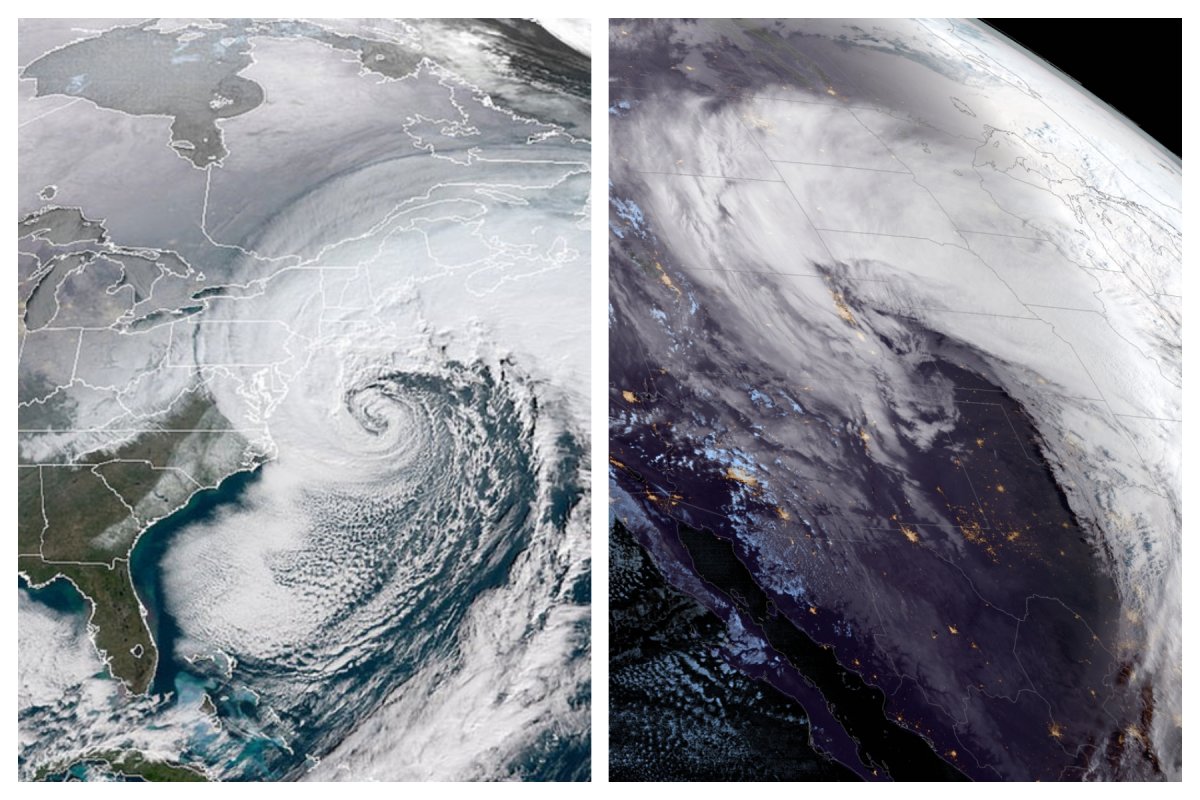The winter storm responsible for the frigid weather currently freezing much of the U.S. may be about to transform into a bomb cyclone.
Images of the powerful blast can be seen in dramatic images taken by satellite. The National Oceanic and Atmospheric Administration (NOAA) GOES-16 satellite has shared images from the past six hours online, where viewers can watch the progression of the cold snap across the country.
Previous spectacular bomb cyclone images have been captured moving across the country, putting the true scale of the storm into relief, with a 2018 and 2019 storm being clearly visible from space as they ravaged the U.S. with blizzards.

What Is a Bomb Cyclone?
Bomb cyclones are extremely strong winter storms caused by large drops in atmospheric pressure.
"Bomb cyclones refer to a more exceptional type of extratropical—or midlatitude—cyclone that is associated with a rapid drop in pressure," Esther Mullens, a professor of atmospheric science at the University of Florida, previously told Newsweek. "The typical criteria is 24 millibars in 24 hours."
In general, winter storms like the arctic blast currently hitting the Midwestern states—known as winter storm Elliott—are formed by a wave of colder air flowing south from the colder north meeting warmer, wetter air.
An Arctic front will continue widespread, dangerous cold, with areas of blinding snow squalls and flash freezing over the central then eastern U.S. through the rest of this week. A strong winter storm will form on this front with blizzard conditions. https://t.co/VyWINDBEpn pic.twitter.com/k2rChNqv1r
— National Weather Service (@NWS) December 22, 2022
"The formation of any mid-latitude storm system requires a contrast of warm air from the lower latitudes and cold, polar air masses from the high latitudes," Jason Furtado, a professor of meteorology at the University of Oklahoma, previously told Newsweek. "As such, middle latitude low-pressure centers feed on this temperature difference."
The arctic blast has made its way south from Canada this week, with a winter storm forming over the Great Lakes region on Thursday. The National Weather Service (NWS) has said that the storm is likely to develop into a bomb cyclone soon.
With a bomb cyclone comes intensely low temperatures, powerful winds and large amounts of snow, leading to blizzard conditions and thick layers of snow.
The NWS forecasts that several states will experience extremely sub-zero temperatures, and that in some areas, wind gusts may exceed 50 miles per hour. Montana, Wyoming and North Dakota were forecasted to have temperatures in as low as the minus 30s and 40s with wind chill.
Ready or not, here it comes! The "Polar Express" (arctic airmass) has already entered NW Arkansas. (looks up last min flights to South FL✈) pic.twitter.com/EjXOG0H16M
— NWS Birmingham (@NWSBirmingham) December 22, 2022
On Thursday afternoon, much of the mainland U.S. was placed under some degree of weather alert by the NWS, impacting over 200 million people.
In 2018 and 2019, bomb cyclones were snapped by the GOES satellite as they crept across the countries. The 2018 storm ended up resulting in 22 deaths and 300,000 people being left without power.
Over 2,681 flights within, into or out of the U.S. were canceled on Thursday and 10,399 flights were delayed, with a further 3,000 at least being canceled on Friday at time of writing, as seen on flight tracking site FlightAware.com.
One positive result of the winter storm and potential bomb cyclone is that up to 19 states may be looking to have a white Christmas on Sunday, including central and eastern Washington state, nearly all of Idaho, Montana, North Dakota, New York and Wyoming, and the northern sections of Colorado, South Dakota, Nebraska, Wisconsin, Illinois, Maine, New Hampshire, Vermont, Pennsylvania, Ohio, Michigan and Minnesota, USA Today reported.
Do you have a tip on a science story that Newsweek should be covering? Do you have a question about bomb cyclones? Let us know via science@newsweek.com.
Uncommon Knowledge
Newsweek is committed to challenging conventional wisdom and finding connections in the search for common ground.
Newsweek is committed to challenging conventional wisdom and finding connections in the search for common ground.
About the writer
Jess Thomson is a Newsweek Science Reporter based in London UK. Her focus is reporting on science, technology and healthcare. ... Read more
To read how Newsweek uses AI as a newsroom tool, Click here.






